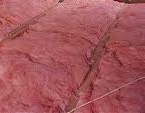Without effective insulation more heat is lost through the roof than either the walls or floor.
There are a range of options for insulating your new home roof with some insulation materials having different effects in summer and winter.
Here are the calculations for my last new house which had a tiled roof with R3.5 Ceiling Batts.
| Element |
R Value Winter |
R Value Summer |
| Outside surface air layer | 0.04 | 0.04 |
| Tiles | 0.02 | 0.02 |
| Roof Space | 0.00 | 0.46 |
| R3.5 Insulation | 3.68 | 3.35 |
| Plasterboard 10mm | 0.06 | 0.06 |
| Inside surface air layer | 0.11 | 0.16 |
| Total R value | 3.91 | 4.09 |
| U value = 1/R | 0.26 | 0.24 |
The heat losses in winter for a 200 sq m roof with rooms at 15 degrees above outside temperature will be:
- Area x ‘U’ x temperature difference = watts
- 200 x 0.26 x 15 = 780w
- Heating Requirement = 0.78kw/hour
The heat gains in summer for a 200 sq m roof with rooms at 10 degrees below outside temperature will be:
- Area x ‘U’ x temperature difference = watts
- 200 x 0.24 x 10 = 480w
- Cooling Requirement = 0.48kw/hour
Remember this isn’t the total heating and cooling requirement as heat is also lost through windows, ceilings floors and ventilation.
To find out about different options have a look at the Insulation Council Handbook.

Your options for roof insulation will depend on the type of roof you have. Pitched (sloping) roofs are more straightforward and there are more options to choose from, while flat roofs and dormer roofs are more of a challenge to insulate.
Good point. See a Flat Roof for more reasons why I prefer a pitched roof.
Brian